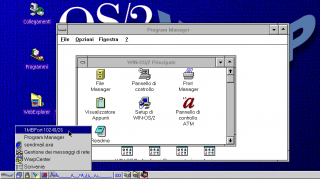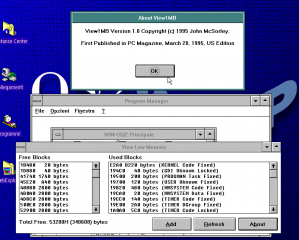This utility solves the "not enough memory" message of Windows programs due to the lack of low memory below 1MB. Source code included.
1MBFort
Version:
1.0
Release date:
Wednesday, 29 March, 1995
Categories:
License:
- Open source (generic)
Interface:
- PMShell
Manual installation
Program is distributed as ZIP package: download to temporary directory and unpack to destination folder. See below for download link(s).
Following ones are the download links for manual installation:
| 1MBFort v. 1.0 (29/3/1995, John McSorley) | Readme/What's new |
1MBFort (VERSION 1.0) Copyright (c) 1995, John McSorley
------------------------------------------------------------------------
First Published in PC Magazine March 29, 1995 (Utilities)
------------------------------------------------------------------------
1MBFort by John McSorley
PURPOSE:
Windows sometimes displays a warning message telling you that
there isn't enough memory to run another program when you have plenty of
memory. This is caused by a lack of low memory, memory below 1MB. 1MBFort
solves this problem by preventing programs from using large blocks of it.
The companion utility View1MB lets you analyze low memory by providing
information about free and allocated blocks.
SETUP:
To install 1MBFort, just copy 1MBFORT.EXE into a directory
on your hard disk. 1MBFort then can be launched in one of two ways.
You can use Program Manager to create an icon in your Windows Startup
group, or add 1MBFORT.EXE to the Load = line of WIN.INI. The second
method is preferable, since it ensures that 1MBFort is the first
application started.
REMARKS:
1MBFort operates invisibly, but you can tell it is running
by checking the Windows Task Manager list. Next to the 1MBFort program
name in Task Manager is the number and size of the fragments created.
By default, the fragment size is 10,240 bytes. This usually works fine,
but you can change the fragment size if you have problems launching
programs.
To change the fragment size, use Windows NotePad or another plain text
editor to edit the file called 1MBFORT.INI in your Windows directory.
The block size 1MBFort uses to create the fragments is set using this
format:
[1MBFORT]
BlockSize = nnnnn
where nnnnn is in the range 5000 to 20000 and indicates the block size
in bytes. If you enter a value below 5000, 1MBFort changes it to 5000.
Likewise, values above 20000 are converted to 20000.
1MBFort can be terminated by selecting it within Task Manager and
pressing the End Task button.
----------------------------------------------------------------------
John McSorley is a programmer/analyst for the Information Technology
Group at a major computer manufacturer.
----------------------------------------------------------------------- |
 hobbes.nmsu.edu/download/pub/windows/1mbfort.zip hobbes.nmsu.edu/download/pub/windows/1mbfort.zip |
 local copy local copy
|
Record updated last time on: 06/06/2021 - 16:16

This work is licensed under a Creative Commons Attribution 4.0 International License.



Add new comment